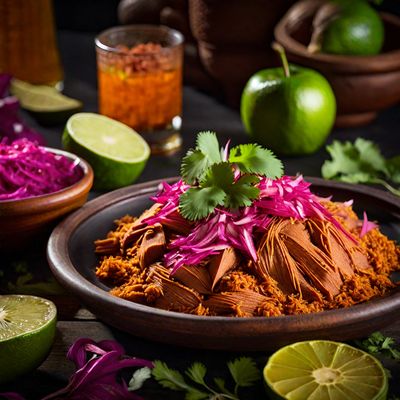
Ingredient
Vinegar, apple
The Sweet-Tart Elixir: Apple Vinegar
Apple vinegar is a pale golden liquid with a distinct sweet-tart flavor. It has a mild acidity that enhances the taste of dishes without overpowering them. The aroma is reminiscent of fresh apples, making it a versatile ingredient in both sweet and savory recipes.
Origins and history
The production of apple vinegar dates back centuries and has roots in ancient Babylon and Egypt. It gained popularity in Europe during the Middle Ages and was used for its medicinal properties. Today, apple vinegar is produced worldwide, with variations in production methods and flavor profiles.
Nutritional information
Apple vinegar is low in calories and contains beneficial compounds like acetic acid, which may aid in digestion and blood sugar control. It also provides small amounts of vitamins and minerals, including potassium.
How to select
When selecting apple vinegar, opt for varieties made from organic apples to ensure the highest quality. Look for unfiltered or raw apple vinegar, as it retains more of the beneficial compounds and has a richer flavor. Avoid any vinegars that appear cloudy or have an off smell.
Storage recommendations
To maintain the freshness and quality of apple vinegar, store it in a cool, dark place away from direct sunlight. Avoid storing it near strong-smelling substances, as vinegar can absorb odors. Properly stored, apple vinegar can last indefinitely, although its flavor may mellow over time.
How to produce
Apple vinegar can be produced at home by fermenting apple juice with the help of beneficial bacteria and yeast. The process involves crushing apples, extracting the juice, and allowing it to ferment in a controlled environment. With time, the natural sugars in the juice are converted into alcohol and then into vinegar.
Preparation tips
Apple vinegar can be used in a variety of ways in the kitchen. It is commonly used in salad dressings, marinades, and pickling brines. It can also be added to sauces, soups, or stews to brighten flavors. In baking, apple vinegar can act as a leavening agent when combined with baking soda. Additionally, it can be diluted with water or other liquids to make a refreshing beverage.
Substitutions
White wine vinegar or cider vinegar can be used as substitutes for apple vinegar, although they may have slightly different flavor profiles. Lemon juice can also provide a similar tangy acidity in some recipes.
Culinary uses
Apple vinegar is a versatile ingredient used in both sweet and savory dishes. It is commonly used in salad dressings, vinaigrettes, and coleslaws to add a tangy kick. It can also be used to pickle vegetables, marinate meats, or deglaze pans for pan sauces. In baking, apple vinegar can be used in cakes, muffins, or quick breads to activate baking soda and create a light texture.
Availability
Worldwide
More ingredients from this category
Recipes using Vinegar, apple » Browse all

Homestyle Creamy Coleslaw
Creamy Delight: A Homestyle Twist on Coleslaw

Vegan Sachertorte
The Ultimate Vegan Chocolate Cake

Authentic Mexican Barbacoa
Savory Slow-Cooked Beef Delight

Silesian-style Stewed Cabbage
Hearty Silesian Cabbage Stew: A Taste of Comfort

Omaha-style Salmagundi
Savory Medley: Omaha's Twist on Salmagundi

Spiced Red Cabbage Delight
Aromatic Hungarian Red Cabbage Medley

German-style Braised Red Cabbage
Hearty Red Cabbage Delight

Homemade Spicy Pepper Jelly
Fiery Fusion: Homemade Spicy Pepper Jelly

Dorset-inspired Spicy Tomato Relish
Dorset's Fiery Tomato Delight

Irish-style Braised Rabbit
Savory Irish Rabbit Stew: A Hearty Delight from the Emerald Isle

Vegan Cochinita Pibil
Plant-Based Twist on a Mexican Classic: Vegan Cochinita Pibil

St. Louis-style Selat Solo
Savory Chicken and Vegetable Salad with a St. Louis Twist
